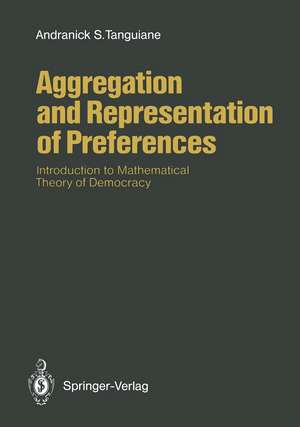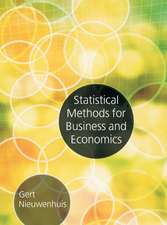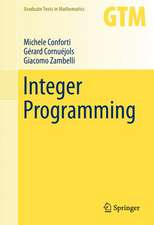Aggregation and Representation of Preferences: Introduction to Mathematical Theory of Democracy
Autor Andranick S. Tanguianeen Limba Engleză Paperback – 22 noi 2011
Preț: 393.90 lei
Nou
Puncte Express: 591
Preț estimativ în valută:
75.38€ • 80.60$ • 62.84£
75.38€ • 80.60$ • 62.84£
Carte tipărită la comandă
Livrare economică 18 aprilie-02 mai
Preluare comenzi: 021 569.72.76
Specificații
ISBN-13: 9783642765186
ISBN-10: 3642765181
Pagini: 348
Ilustrații: IX, 331 p.
Dimensiuni: 170 x 242 x 18 mm
Greutate: 0.55 kg
Ediția:Softcover reprint of the original 1st ed. 1991
Editura: Springer Berlin, Heidelberg
Colecția Springer
Locul publicării:Berlin, Heidelberg, Germany
ISBN-10: 3642765181
Pagini: 348
Ilustrații: IX, 331 p.
Dimensiuni: 170 x 242 x 18 mm
Greutate: 0.55 kg
Ediția:Softcover reprint of the original 1st ed. 1991
Editura: Springer Berlin, Heidelberg
Colecția Springer
Locul publicării:Berlin, Heidelberg, Germany
Public țintă
ResearchCuprins
1 Different Ways of Aggregation of Preferences.- 1.1 Aggregation of Preferences as a Voting Problem.- 1.2 Aggregation of Preferences by a Majority Rule.- 1.3 Aggregation of Preferences with Account of Degree of Preference.- 1.4 Ordinal and Cardinal Approaches to Aggregation of Preferences.- 1.5 Alternate View at Aggregation of Preferences.- 2 Preferences and Goal Functions.- 2.1 Introductory Remarks.- 2.2 Binary Relations and Orderings.- 2.3 Continuous Orderings.- 2.4 Numerical Representation of Orderings.- 3 Aggregation of Fixed Independent Preferences.- 3.1 Introductory Remarks.- 3.2 Construction of Approximation of Additive Goal Function.- 3.3 Accuracy of Approximation of Additive Goal Function.- 3.4 Applicability of the Construction of Additive Goal Function.- 3.5 Notes on Interpretation.- 4 Accounting Degree of Preference in Aggregation.- 4.1 Introductory Remarks.- 4.2 Method of Marks.- 4.3 Certainty of Predominance of One Preference over Another.- 4.4 Notes on Interpretation.- 5 General Model of Aggregation of Preferences.- 5.1 Introductory Remarks.- 5.2 Aggregating Operators and Deciding Hierarchies.- 5.3 Bijection Theorem.- 5.4 Theorems of Arrow and Fishburn.- 5.5 Representation of Model of Aggregation of Preferences.- 5.6 Topological Formulation of Model of Aggregation of Preferences.- 5.7 Notes on Interpretation.- 6 Aggregation of Infinite Set of Preferences.- 6.1 Introductory Remarks.- 6.2 Imbeddings of Models of Aggregation of Preferences.- 6.3 Limit Theorem.- 6.4 Sequential Aggregation of Preferences.- 6.5 Reduction of Model and Notes on Interpretation.- 7 Interpretation of Dictator as Representative.- 7.1 Introductory Remarks.- 7.2 Indicators of Representativeness.- 7.3 Representativeness of Optimal and Random Dictators.- 7.4 Overcoming Arrow’s Paradox.-7.5 Independence of Individuals.- 7.6 Average Representativeness for Independent Individuals.- 7.7 Approximation of Majority Representativeness.- 7.8 Geometric Interpretation of Dictators.- 7.9 Numerical Estimation of Representativeness.- 7.10 Notes on Interpretation.- 8 Representation of Collective by Few Individuals.- 8.1 Introductory Remarks.- 8.2 Cabinets and Indicators of Their Representativeness.- 8.3 Representativeness of Optimal and Random Cabinets.- 8.4 Recurrent Construction of Cabinets.- 8.5 Representativeness of Cabinets for Independent Individuals.- 8.6 Consistency of Two Definitions of Optimal Cabinets.- 8.7 Numerical Estimation of Representativeness of Cabinets.- 8.8 Notes on Interpretation.- 9 Representation of Collective by a Council.- 9.1 Introductory Remarks.- 9.2 Councils and Indicators of Their Representativeness.- 9.3 Representativeness of Optimal and Random Councils.- 9.4 Representativeness of Councils for Independent Individuals.- 9.5 Consistency of Two Definitions of Optimal Councils.- 9.6 Numerical Estimation of Representativeness of Councils.- 9.7 Notes on Interpretation.- Conclusions.- Appendix 2. Tables A.2.1–A.2.6. Lower Bound of Representativeness of Optimal Cabinets.- Appendix 3. Tables A.3.1–A.3.6. Lower Bound of Representativeness of Optimal Councils.- References.- Name Index.- Designations.











